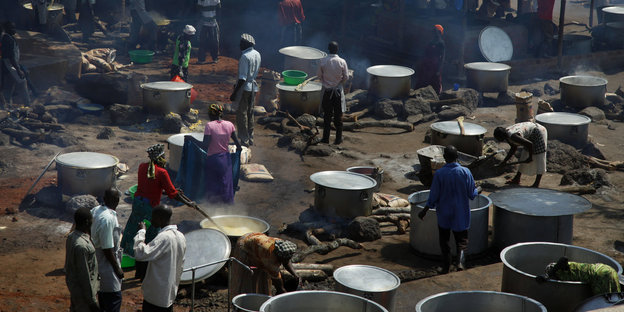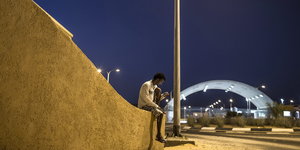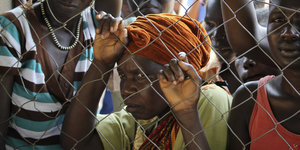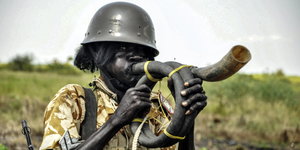Migration policy in Uganda: Economically potent flagship
It acts as a virtual paradise for refugees in the heart of war torn Africa, whilst the economy booms – a success story.

South Sudanese refugees in Uganda Foto: ap
Uganda is an example of a liberal refugee policy, not only in Africa but across the globe. This is what Filippo Grandi, the UN High Commissioner for the UN Refugee Agency, emphasized at a press conference in Uganda's capital, Kampala, later reiterating this praise in front of the UN General Assembly in New York. In August, during a short visit to the north of the country he returned back to the border. He had visited the refugee reception camps there, where over 80,000 refugees from South Sudan are seeking safety. Since fighting re-ignited in Uganda's northern neighbour in July thousands of South Sudanese refugees have been escaping over the border. At present the small country has offered refuge to over 800,000 people in total. Now Uganda runs the third largest refugee camp in the world.
This small country with a population of around 38 million is an island of stability in the crisis-ridden heart of the continent. The Democratic Republic of Congo, Uganda's westerly neighbour, has been at war for over 2 decades, and in South Sudan, to the north of Uganda, violent conflict broke out at the end of 2013, which was renewed in July this year after a failed peace treaty. In Burundi the government terrorises its citizens. More than 200,000 people have fled to neighbouring countries, most of them to Rwanda and Tanzania; but the camps there are overcrowded. The Burundians are now also continuing on to Uganda, because they know that once there they too can establish themselves in the long term. The Ugandan government quickly offers them asylum without lengthy application processes or restrictions and they are then assigned a piece of land, where they can build a house and a field to farm or a work permit so that they can set up a shop, a workshop or a restaurant.
In 2006 Uganda’s parliament adopted a law on refugees, that respects all international standards which came into effect in 2008. Progressive politics are being implemented institutionally into the president's offices, where there is a department for refugee matters. They are working closely with UN aid agencies and international NGOs because Uganda’s budget is unable to cope with the flow of migration.
A pragmatic approach
Uganda’s liberal Refugee policy has a history. During the 1970s and 1980s, when the dictators Idi Amin and Milton Obote ruled with terror, many Ugandans themselves fled as refugees to their neighbouring countries. The current Ugandan President, Yoweri Museveni, lived in exile in Tanzania where he formed his guerrilla movement, which eventually retook the country in 1986 and this government remains in power to this date.
This policy of welcoming refugees is an essential part of President Museveni's regional power-politics. Currently, Uganda plays host to oppositional forces from Burundi, South Sudan, Rwanda or even from Somalia and Ethiopia. This includes former armed rebels, who lost the war in their own countries and are recuperating in Uganda, such as the Congo's M23 Rebels (formed during the March 23 Movement). They retreated across the border with all of their weapons following their defeat by the army of Congo and UN peacekeepers in November 2013. Museveni hosts up to one thousand fighters as a bargaining chip and keeps them going; they are a valuable asset.
Uganda’s economy is also benefitting. The rich, who want to ensure the safety of their possessions, are the first to leave countries in crisis, followed by the middle class, such as business owners and small traders. Some bring their grain mills, circular saws or sewing machines. They rent a house, open a shop or restaurant, do trade with their relatives at home, whilst paying taxes and hiring a couple of Ugandans. The UN's World Food Programme purchases food from local Ugandan farmers at a fair price. A study conducted by the World Food Programme, published in October 2016, states that each piece of arable land, which is made available for refugee families, generates around 200 euros revenue per year. An advantage for Uganda’s economy.
The aim is that after five years, thanks to their own farm, the refugees can provide for themselves. Initial aid such as building materials, cooking equipment, clothing and food supplies, as well as the maintenance of the camp, is provided by international donors such as the UN Refugee Agency (UNHCR) or the UN World Food Programme (WFP). However, as a result of the global crisis these organisations are now in a difficult financial situation and this may have far-reaching consequences.
The High Commissioner of the UNHCR Grandi must have also realised this when he visited the reception camps in the Adjumani district. Many do not receive cooking equipment or clothes. The rations per person have been halved. According to Grandi, less than a quarter of the funds needed were made available by the donors. The reason is that news headlines are dominated by the humanitarian crisis in Syria. However Grandi urges that, „if the world is focussed on refugee crises, then the crisis here should receive just as much support.“
Uganda's Prime Minister Rukana Rukunda has also stressed that „this crisis cannot be seen as Uganda's responsibility alone, the rest of the world must help us cope with it.“ She has also added that „we will continue to support the refugees – with or without monetary aid from the EU.“
His government has signed the agreement of the Khartoum process, but it only plays a marginal role. Actions envisaged and discussed for Uganda were: Better methods to identify vulnerable people and better monitoring of Uganda’s borders.
According to the Agreement of Valletta in November 2015, Uganda benefits from the EU-Trust Fund. The aim of all these projects: To improve the lives of refugees and their communities. The EU invests around five million euros in projects in Kampala's slums with financial aid from the IOM (International Organisation for Migration). Here is a shelter for those refugees who don't want to live and be looked after in the refugee camps but who also have no money of their own, in order to look after themselves in the cities. Poverty and petty crime lead to conflicts with the Ugandans.
Under the gigantic Gaddafi Mosque, the Kisenyi Quarter in Uganda's colonial old town is currently said to be a flashpoint. 90 per cent of the inhabitants are of Somali origin. Here people speak Somali, pray to Mecca, eat spaghetti and buy all kinds of cannabis concoctions, which is the traditional drug in Somalia. The Somali Islamists who had been jumping up and down during the final match of the 2010 World Cup in Kampala, had prepared the attacks in these slums, underground. “Civilian peace-making, conflict prevention and resolution“ are the names of the measures, by which the EU-Trust fund supports health centres, schools and training schemes in these slums.
The EU is investing a further ten million in the regions along the border with South Sudan, namely in Adjumani and Kiryandongo. There, the majority of the South Sudanese – around 160,000 in total – who had fled the country since 2013, live in reception centres. The Government of Uganda will endeavour to resettle refugees in the large settlements in the interior of the country, since it owns no land that it can make available in Adjumani and Kiryandongo. There, the land belongs to the local communities. Most of the South Sudanese refuse to move away from the border; they have not given up the hope of being able to return soon to their country. The mass of refugees in the border regions are a cause of conflict because the local population feels supplanted. The two regions have a local population of about 200,000, but hardly any schools, health centres, electricity or water supply. The EU is now investing in a regional development programme in the local economy and infrastructure.
Uganda: an important factor of stability
Uganda is considered as a guarantor of stability in the region: Ugandan soldiers, with over 6000 of them, account for the lion’s share of the African Union Military Mission in Somalia (AMISOM), financed by the EU. Since the beginning of 2007, the EU has provided more than one billion euros for the salaries of African-Union soldiers and police officers, the equipment and catering. However, due to the development of EU military missions in Mali, Nigeria and the Central African Republic at the beginning of 2016, the EU has reduced its share by 20 per cent.
In the first half of 2016, the Ugandan Armed Forces (UPDF) complained about outstanding payments to their soldiers in Somalia. The Ugandan soldiers had received no salary for more than four months, according to UPDF Spokesman Colonel Paddy Ankunda who spoke to TAZ in August. He threatened that Uganda would exit the mission in 2017; then, in September, the EU promised once again USD 178 million.
Ugandan Soldiers are also fighting in South Sudan; not, however, within the framework of the UN or AU, but at the personal invitation of South Sudan's President Salva Kiir, after his own army had crumbled. President Museveni is reluctant to put his troops under a superordinate UN mandate; he categorically rejects the UN weapons' embargo although Uganda sends a large part of the military equipment to Juba.
In the scope of the EU regional programme for the Horn of Africa, the „Regional Action plan of 2015-2020“, in which the Regional Organisation IGAD (Intergovernmental Authority on Development), the AU as well as the East African Union are also supported, it is all about the following points: security, migration, arms trade inside the region, climate disasters as reasons for fleeing and prevention of the radicalisation of youth. Here too the EU extends its financial support. Uganda’s President is regarded as a steadfast advocate of integration in the East African Community (EAC), which guarantees the free movement of persons, goods and manpower in the Member States.
As a result of that Kenya, Uganda and Rwanda have already drawn up joint tourist visas; an EAC passport will also be printed soon. In order to enable the free movement of people within the EAC, Uganda has greatly expanded its border infrastructure in the past years. Almost all of the 40 border-crossing points have been equipped with fingerprint scanners and reading devices for biometric passports. EAC citizens no longer need a work permit within the Community. In East Africa a quasi-blueprint of the Schengen Zone has come to being in recent years – based in large part on the EU.
For Uganda, borders kept being flashpoints: most of them are neither demarcated, nor watched or specifically formalised – thus they are disputed. In the western border region – around Lake Edward – with the Democratic Republic of Congo as well as in the North East along the border with Kenya's Turkana region, huge oil reserves had been found. The neighbouring countries are now in dispute over every square metre of land. In the South along Lake Victoria's shore, there are border conflicts with Kenia and Tanzania; there it's about the shrinking fish stock.
Foreign aid for border control
Uganda's border authority lacks vehicles, in order to be able to control remote borders through inhospitable regions in the mountains and desert-like savannas. In 2016 Japan spent a lot on off-road vehicles and other expensive forensic equipment.
The desire for increased migration control was put in place as a result of the 2010 bomb attacks, when Somali immigrants were identified as the perpetrators. The International Civil Aviation Organisation (ICAO) had formalised 2015 as the deadline for the global introduction of biometric passports. Shortly before the end of the deadline, Ugandan immigration authorities started to issue biometric passports in 2015. On their chip, photos, eye scans and fingerprints are stored, which are connected with Interpol’s databases.
Since July 2016 foreign visitors must apply for a visa electronically. Now everybody is checked over by the Secret Service. The link between the e-visa and biometric databases is yet to be done. The government lacks the hardware to deal with all the additional data and store them. Until two years ago there was not a single computer at the immigration authorities in Kampala; piles of applications were stacked in coloured folders up to the ceiling. Only recently, was the necessary equipment purchased to process digital files.
By doing so, the Immigration Authority was incorporated under the Department of Homeland Security and on several occasions personnel was shuffled and constantly militarised. Ex-army chief General Aronda Nyakairima became Interior Minister in 2013 and he brought the military intelligence CMI on board. The general died unexpectedly in 2015 during a mission abroad. After the 2016 elections General Haji Abubaker Jeje Odongo – former Minister of Defence – became Interior Minister.
Already in 2005, it had been decided by Uganda’s government to issue national identity cards to make the electoral process more secure. There have been regular scandals in awarding this major contract of approximately 64 million euros. Ultimately, President Museveni commissioned the German company Mühlbauer Technologies. This deal was arranged by the German former Ambassador Reinhard Buchholz, a trusted friend of Museveni, who introduced the company founder Josef Mühlbauer to the President during a midnight meeting in 2010. Shortly afterwards, the President ordered that Mühlbauer should print 15,000 ID cards, bypassing all legally formalised bidding processes. Two years and numerous scandals later, all the money had been paid out, even though the Bavarian company had printed only roughly 400 plastic cards. After fierce debates in Parliament and enquiry committees that had been set up as a result, Uganda's army finally undertook the project.




